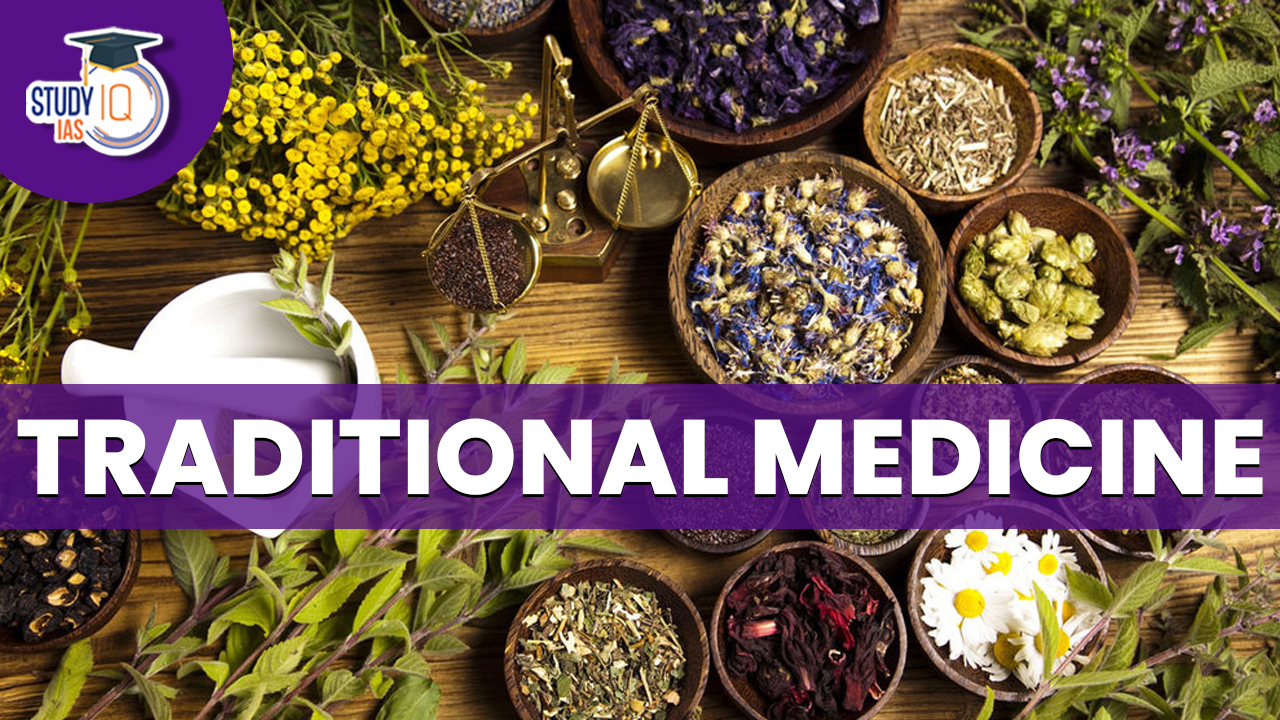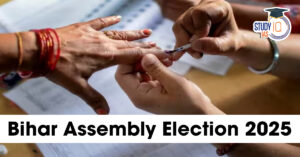Table of Contents
Context: The inaugural worldwide summit on traditional medicine by the World Health Organization (WHO) took place during the G-20 Health Ministers’ meeting in Gandhinagar.
What is Traditional Medicine?
- Traditional medicine, as defined by the World Health Organization (WHO), refers to the knowledge, skills, and practices that various cultures have developed over time to maintain health, prevent, diagnose, and treat physical and mental illnesses.
- It encompasses a wide range of ancient and modern practices used in different regions around the world.
- In India, traditional medicine includes various indigenous practices and therapies that have been part of the country’s historical tradition.
- Some of the well-known traditional medicine systems in India are:
- Ayurveda: Ayurveda is an ancient Indian system of medicine that focuses on balancing the body’s energies (doshas) to promote health and prevent diseases. It includes herbal medicines, diet, lifestyle modifications, and therapies like massage and Panchakarma.
- Yoga: Yoga is a holistic practice that originated in ancient India and includes physical postures, breathing exercises, meditation, and ethical principles. It is not only a physical exercise but also a mental and spiritual practice to enhance overall well-being.
- Siddha: The Siddha system of medicine is practiced predominantly in Tamil Nadu and Kerala. It is an ancient medical system that originated in Tamil Nadu and is based on the concept of maintaining a balance between the five elements (earth, water, fire, air, and ether) in the body.
- Sowa-Rigpa (Tibetan Medicine): Sowa-Rigpa is a traditional medical system practiced mainly in the Himalayan regions such as Sikkim, Arunachal Pradesh, Darjeeling, Lahaul & Spiti, and Leh-Ladakh. It is influenced by both Ayurveda and traditional Tibetan medicine.
- Homoeopathy: While not originally part of Indian tradition, homoeopathy has become an integral part of India’s traditional medicine practices over the years. Homoeopathy is based on the principle of “like cures like” and uses highly diluted substances to stimulate the body’s healing response.
Importance of Traditional Medicine in Healthcare
- Cultural Wisdom: Traditional medicine is deeply intertwined with cultural practices, beliefs, and experiences, making it a valuable repository of diverse healthcare insights.
- Holistic Approach: Unlike some modern medical systems that focus solely on specific symptoms or diseases, traditional medicine emphasizes the interconnectedness of the body, mind, and spirit.
- Natural Remedies: Traditional medicine often relies on natural ingredients such as herbs, plants, and minerals, which are gentler on the body and may have fewer side effects compared to synthetic drugs.
- Preventive Care: Traditional medicine places great importance on prevention rather than just treatment.
- Accessible and Affordable: Traditional medicine often uses locally available resources, making it more accessible and affordable, particularly in rural or underserved areas.
- Global Interest: Traditional medicine has gained recognition on the global stage, leading to research and scientific validation of its effectiveness.
The Traditional Medicine Ecosystem in India
- The market for medicinal plants in India stood at Rs. 4.2 billion ($ 56.6 million) in 2019 and is expected to increase at a CAGR of 38.5 percent to Rs. 14 billion (US$ 188.6 million) by 2030.
- The export value of ayurvedic and herbal products amounted to about $539 million from India in 2021.
- Overall, AYUSH exports have reached $18 billion from $3 billion before 2014. AYUSH stands for Ayurveda, Yoga, Naturopathy, Unani, Siddha and Homoeopathy.
- About 40,000 MSMEs are active in the AYUSH sector.
Major Concerns with the Traditional Systems of Medicine in India
- Trust-Deficit: There is a major trust-deficit in the soundness of Ayurvedic theories and the fruitfulness of its practices. Ayurveda is not the medical system of first choice for many people.
- Lack of Scientific Validation: Ayurveda has failed to keep pace with the intellectual and scientific advances of the times. So, it has diminished evidence-based quality.
- Sub Standard Courses: Ayurvedic practitioners’ graduation courses are often substandard and the post-graduate courses offered at most of their institutes are of extremely poor quality.
- Lack of Practice: While MBBS graduates and post-graduates from public hospitals have to mandatorily serve a specified bond period in rural areas, graduates and post-graduates from AYUSH public hospitals are not subjected to any such restrictions.
- Lack of Ecosystem: Ayurveda lacks a vibrant ecosystem of science and research.
- Trial and Error Methods: Ayurvedic practitioners have to discover treatments and approaches that actually work. It involves a lot of trial and error with patients and leads to an erosion of the practitioner’s reputation.
- Lack of Investment: Despite numerous efforts made by individuals and organizations to conduct research, the lack of investment into Ayurvedic research has been a major setback.
- Less Integration with Modern Medicine: Ayurveda can be used safely and efficaciously only in about 60%-70% of primary-care illnesses. For rest, Ayurveda needs to be integrated with modern medicine.
Initiatives to Promote Traditional Medicine
- Ministry of AYUSH: The Ministry of AYUSH was established in 2014 with a vision of reviving the profound knowledge of our ancient systems of medicine.
- National AYUSH Mission (NAM): Government of India is implementing Centrally Sponsored Scheme of NAM in the country through State and UTs for promotion and development of AYUSH systems.
- Grant-in-aid is being provided to State Governments for development and promotion of Ayurveda, Yoga & Naturopathy, Unani, Siddha and Homoeopathy.
- NAM also supports cultivation of medical plants, production of quality and standardized ingredient for supply of AYUSH, integration of medicinal plants in farming systems and increasing export of value-added items of medicinal plants.
- AYUSH Gram: Under the concept of AYUSH Gram, AYUSH based lifestyles are promoted through behavioral change communication, training of village health workers towards identification and use of local medicinal herbs and provision of AYUSH health services.
- Global partnerships: India has signed MOUs with 23 countries for cooperation in field of Traditional Medicine and Homoeopathy in areas such as research, education, training, and more.
- 33 AYUSH Information Cell have been set up in 31 countries to disseminate authentic information about AYUSH systems.
- WHO Global Centre for Traditional Medicine (GCTM):
- WHO GCTM was established in Jamnagar, Gujarat. It is the first WHO GCTM in the world.
- The centre was established to support WHO’s efforts to implement the WHO Traditional Medicine Strategy 2014-2023.
- The government has special AYUSH Visa category for foreign nationals, who want to come to India to take advantage of AYUSH therapy.
- A special AYUSH mark for AYUSH products and network of AYUSH parks has been undertaken to encourage the promotion, research and manufacturing of AYUSH products in India.
- A new category named ‘AYUSH Aahar’ has been announced which facilitates the producers of Ayurvedic nutritional supplements.
- With the aim of boosting infrastructure and promoting research in traditional medicine, three National AYUSH Institutes have been established:
- All India Institute of Ayurveda (AIIA), Goa, National Institute of Unani Medicine (NIUM), Ghaziabad and the National Institute of Homoeopathy (NIH) have been set up.
- Ministry of Electronics and Information Technology is providing technical support for digitalisation of AYUSH Sector under the AYUSH Grid project.
- The Traditional Knowledge Digital Library has been created which contains information about Ayurveda, Unani, Siddha, Sowa Rigpa and Yoga.


 Phone-tapping in India, Legal Framework ...
Phone-tapping in India, Legal Framework ...
 Bihar Assembly Election 2025 Dates, Poli...
Bihar Assembly Election 2025 Dates, Poli...
 Jharkhand High Court Assistants Admit Ca...
Jharkhand High Court Assistants Admit Ca...





















